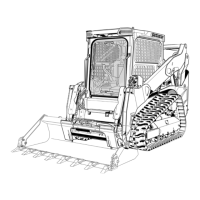• Perform
the maintenance work on the machine
only on level ground with the engine off and the
armrest in the raised position.
Checks
• Go
around the machine and check for visual
damage and wear.
• Check the coolant level.
(See Checking the coolant level on page 155)
• Check the fuel level.
• Check the engine oil level.
• Check the hydraulic fluid level.
• Check all control lamps, indicators, and the hour
meter.
• Check the light system.
• Check the seat belt and the ROPS and FOPS
safety device.
• Check the diesel-particulate-filter (DPF) muffler.
• Check the condition of the safety labels.
(See Care for safety labels on page 24)
• Check around moving parts such as quick hitch,
bucket cylinder, arm cylinder for sand, mud, or
debris accumulation. Remove them as required.
2. Checking the coolant level
WARNING
T
o avoid personal injury or death:
• Place the machine on a firm, flat, and level
surface, lower the lift arms slowly to the
ground, and stop the engine.
• Do not open the radiator cap right after the
engine has been stopped. Serious burns can
occur from contact with escaping hot coolant
fluid.
• Check the coolant level in the coolant-recovery
tank only after the engine has cooled down.
• Remove the radiator cap only if absolutely
necessary.
1. Check
to see that the coolant level is between the
[FULL] and [LOW] marks of coolant-recovery tank.
When the coolant level drops due to evaporation,
add water only up to the full level.
In case of leakage, add antifreeze and water in the
specified mixing ratio up to the full level.
(1) Coolant recovery tank (A) FULL
(B)
LOW
IMPORTANT :
• Do
not fill the coolant-recovery tank over the
[FULL] marking.
• Do not fill with dirty or salty water.
3. Checking the fuel level
WARNING
T
o avoid personal injury or death:
• Stop the engine before fueling.
• Do not smoke while fueling.
• Tighten the fuel cap after refueling.
IMPORTANT :
• According to the temperatures, use the proper
diesel fuel as follows.
Temperatures Diesel fuel
Over -5 ℃ No.2-D diesel fuel
Under -5 ℃ No.1-D diesel fuel
• Make
sure that the fuel tank will not run empty.
Air will enter the fuel system, and must be
purged before restarting engine.
• Be very attentive to the remaining fuel for the
engine not to stall. If the engine stalls, it may
not restart for some time to protect the
emission purifying device.
• See Purging of the fuel system on page 180.
• To prevent condensation (water) accumulations
in the fuel tank, fill the fuel tank full before
parking overnight.
DAILY CHECKS MAINTENANCE

